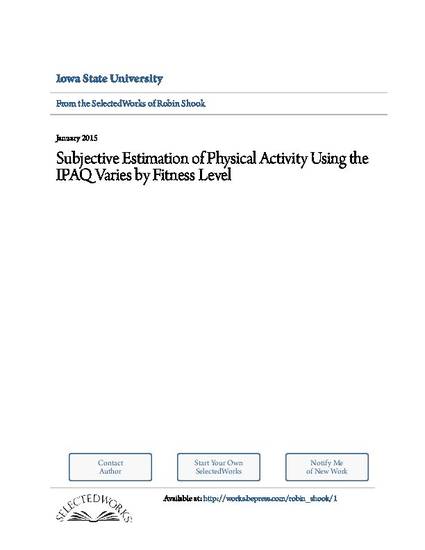
Article
Subjective Estimation of Physical Activity Using the IPAQ Varies by Fitness Level
Journal of Physical Activity & Health
Document Type
Article
Disciplines
Publication Version
Accepted Manuscript
Publication Date
4-5-2015
DOI
10.1123/jpah.2014-0543
Abstract
Background: Subjective measures of moderate and vigorous physical activity (MVPA) rely on ‘relative’ intensity while objective measures capture ‘absolute’ intensity, thus fit individuals may perceive the same activity differently than unfit individuals. Methods: Adults (N=211) wore the SenseWear Armband (SWA) for ten consecutive days to objectively assess sedentary time and MVPA. On day eight participants completed the International Physical Activity Questionnaire (IPAQ) to subjectively assess sitting time and MVPA. Fitness was assessed via a maximal treadmill test, and participants were classified as ’unfit’ if the result was in the bottom tertile of the study population by sex or ‘fit’ if in the upper two tertiles. Results: Overall, estimates of MVPA between the IPAQ and SWA were not significantly different (IPAQ minus SWA, 67.4±919.1 MVPA minutes/week, P=.29). However, unfit participants overestimated MVPA using the IPAQ by 37.3% (P=.02), but fit participants did not (P=.99). This between-group difference was due to overestimation using the IPAQ of moderate activity by 93.8 minutes/week among the unfit individuals, but underestimation of moderate activity among the fit participants by 149.4 minutes/week. Conclusion: Subjective measures of MVPA using the IPAQ varied by fitness category, with unfit participants overestimating their MVPA and fit participants accurately estimating their MVPA.
Copyright Owner
Human Kinetics
Copyright Date
2015
Language
en
File Format
application/pdf
Citation Information
Robin P. Shook, Nicole C. Gribben, Gregory A. Hand, Amanda E. Paluch, et al.. "Subjective Estimation of Physical Activity Using the IPAQ Varies by Fitness Level" Journal of Physical Activity & Health (2015) Available at: http://works.bepress.com/robin_shook/2/

This is a manuscript of an article from Journal of Physical Activity & Health; April 2015; doi: 10.1123/jpah.2014-0543. Posted with permission.